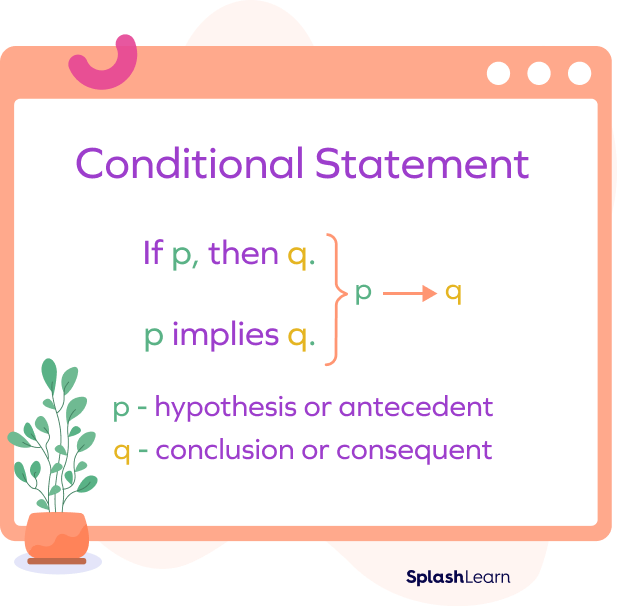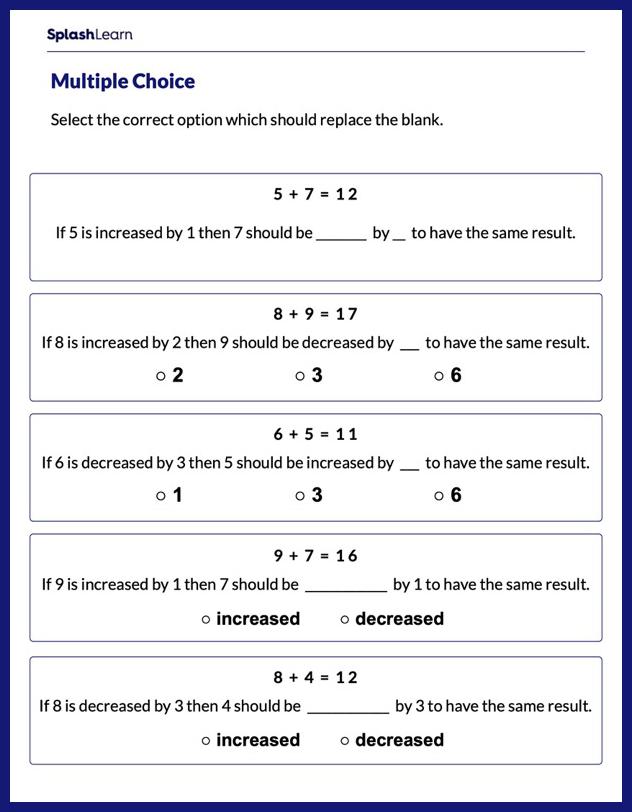What Is a Conditional Statement?
A conditional statement is a statement that is written in the “If p, then q” format. Here, the statement p is called the hypothesis and q is called the conclusion. It is a fundamental concept in logic and mathematics.
Conditional statement symbol: p → q
A conditional statement consists of two parts.
- The “if” clause, which presents a condition or hypothesis.
- The “then” clause, which indicates the consequence or result that follows if the condition is true.
Example: If you brush your teeth, then you won’t get cavities.
Hypothesis (Condition): If you brush your teeth
Conclusion (Consequence): then you won’t get cavities

Recommended Games
Conditional Statement: Definition
A conditional statement is characterized by the presence of “if” as an antecedent and “then” as a consequent. A conditional statement, also known as an “if-then” statement consists of two parts:
- The “if” clause (hypothesis): This part presents a condition, situation, or assertion. It is the initial condition that is being considered.
- The “then” clause (conclusion): This part indicates the consequence, result, or action that will occur if the condition presented in the “if” clause is true or satisfied.
Recommended Worksheets
Representation of Conditional Statement
The conditional statement of the form ‘If p, then q” is represented as p → q.
It is pronounced as “p implies q.”
Different ways to express a conditional statement are:
- p implies q
- p is sufficient for q
- q is necessary for p
- p ⇒ q
Parts of a Conditional Statement
There are two parts of conditional statements, hypothesis and conclusion. The hypothesis or condition will begin with the “if” part, and the conclusion or action will begin with the “then” part. A conditional statement is also called “implication.”
Conditional Statements Examples:
Example 1: If it is Sunday, then you can go to play.
Hypothesis: If it is Sunday
Conclusion: then you can go to play.
Example 2: If you eat all vegetables, then you can have the dessert.
Condition: If you eat all vegetables
Conclusion: then you can have the dessert
How to Write a Conditional Statement
To form a conditional statement, follow these concise steps:
Step 1: Identify the condition (antecedent or “if” part) and the consequence (consequent or “then” part) of the statement.
Step 2: Use the “if… then…” structure to connect the condition and consequence.
Step 3: Ensure the statement expresses a logical relationship where the condition leads to the consequence.
Example 1: “If you study (condition), then you will pass the exam (consequence).”
This conditional statement asserts that studying leads to passing the exam. If you study (condition is true), then you will pass the exam (consequence is also true).
Example 2: If you arrange the numbers from smallest to largest, then you will have an ascending order.
Hypothesis: If you arrange the numbers from smallest to largest
Conclusion: then you will have an ascending order
Truth Table for Conditional Statement
The truth table for a conditional statement is a table used in logic to explore the relationship between the truth values of two statements. It lists all possible combinations of truth values for “p” and “q” and determines whether the conditional statement is true or false for each combination.
The truth value of p → q is false only when p is true and q is False.
If the condition is false, the consequence doesn’t affect the truth of the conditional; it’s always true.
In all the other cases, it is true.
| p | q | p → q |
|---|---|---|
| T | T | T |
| T | F | F |
| F | T | T |
| F | F | T |
The truth table is helpful in the analysis of possible combinations of truth values for hypothesis or condition and conclusion or action. It is useful to understand the presence of truth or false statements.
Converse, Inverse, and Contrapositive
The converse, inverse, and contrapositive are three related conditional statements that are derived from an original conditional statement “p → q.”
| Conditional Statement | p → q |
| Converse | q → p |
| Inverse | ~p → ~q |
| Contrapositive | ~q → ~p |
Consider a conditional statement: If I run, then I feel great.
- Converse:
The converse of “p → q” is “q → p.” It reverses the order of the original statement. While the original statement says “if p, then q,” the converse says “if q, then p.”
Converse: If I feel great, then I run.
- Inverse:
The inverse of “p → q” is “~p → ~q,” where “” denotes negation (opposite). It negates both the antecedent (p) and the consequent (q). So, if the original statement says “if p, then q,” the inverse says “if not p, then not q.”
Inverse: If I don’t run, then I don’t feel great.
- Contrapositive:
The contrapositive of “p → q” is “~q → ~p.” It reverses the order and also negates both the statements. So, if the original statement says “if p, then q,” the contrapositive says “if not q, then not p.”
Contrapositive: If I don’t feel great, then I don’t run.
What Is a Biconditional Statement?
A biconditional statement is a type of compound statement in logic that expresses a bidirectional or two-way relationship between two statements. It asserts that “p” is true if and only if “q” is true, and vice versa. In symbolic notation, a biconditional statement is represented as “p ⟺ q.”
In simpler terms, a biconditional statement means that the truth of “p” and “q” are interdependent.
If “p” is true, then “q” must also be true, and if “q” is true, then “p” must be true. Conversely, if “p” is false, then “q” must be false, and if “q” is false, then “p” must be false.
Biconditional statements are often used to express equality, equivalence, or conditions where two statements are mutually dependent for their truth values.
Examples:
- I will stop my bike if and only if the traffic light is red.
- I will stay if and only if you play my favorite song.
Facts about Conditional Statements
- The negation of a conditional statement “p → q” is expressed as “p and not q.” It is denoted as “𝑝 ∧ ∼𝑞.”
- The conditional statement is not logically equivalent to its converse and inverse.
- The conditional statement is logically equivalent to its contrapositive.
- Thus, we can write p → q ∼q → ∼p
Conclusion
In this article, we learned about the fundamentals of conditional statements in mathematical logic, including their structure, parts, truth tables, conditional logic examples, and various related concepts. Understanding conditional statements is key to logical reasoning and problem-solving. Now, let’s solve a few examples and practice MCQs for better comprehension.
Solved Examples on Conditional Statements
Example 1: Identify the hypothesis and conclusion.
If you sing, then I will dance.
Solution:
Given statement: If you sing, then I will dance.
Here, the antecedent or the hypothesis is “if you sing.”
The conclusion is “then I will dance.”
Example 2: State the converse of the statement: “If the switch is off, then the machine won’t work.”
Solution:
Here, p: The switch is off
q: The machine won’t work.
The conditional statement can be denoted as p → q.
Converse of p → q is written by reversing the order of p and q in the original statement.
Converse of p → q is q → p.
Converse of p → q: q → p: If the machine won’t work, then the switch is off.
Example 3: What is the truth value of the given conditional statement?
If 2+2=5, then pigs can fly.
Solution:
p: 2+2=5
q: Pigs can fly.
The statement p is false. Now regardless of the truth value of statement q, the overall statement will be true.
F → F = T
Hence, the truth value of the statement is true.
Practice Problems on Conditional Statements
Conditional Statement - Definition, Truth Table, Examples, FAQs
What is the antecedent in the given conditional statement? If it’s sunny, then I’ll go to the beach.
Antecedent refers to the first part which states the hypothesis or the condition in the statement.
A conditional statement can be expressed as
All these are different ways to represent a conditional statement.
What is the converse of “a → b”?
To find the converse, reverse the order of the statements a and b.
Converse of a → b is b → a.
When the antecedent is true and the consequent is false, the conditional statement is
A conditional statement is considered false when the antecedent is true and the consequent is false.
Frequently Asked Questions about Conditional Statements
What is the meaning of conditional statements?
Conditional statements, also known as “if-then” statements, express a cause-and-effect or logical relationship between two propositions.
When does the truth value of a conditional statement is F?
A conditional statement is considered false when the antecedent is true and the consequent is false.
What is the contrapositive of a conditional statement?
The contrapositive reverses the order of the statements and also negates both the statements. It is equivalent in truth value to the original statement.






















